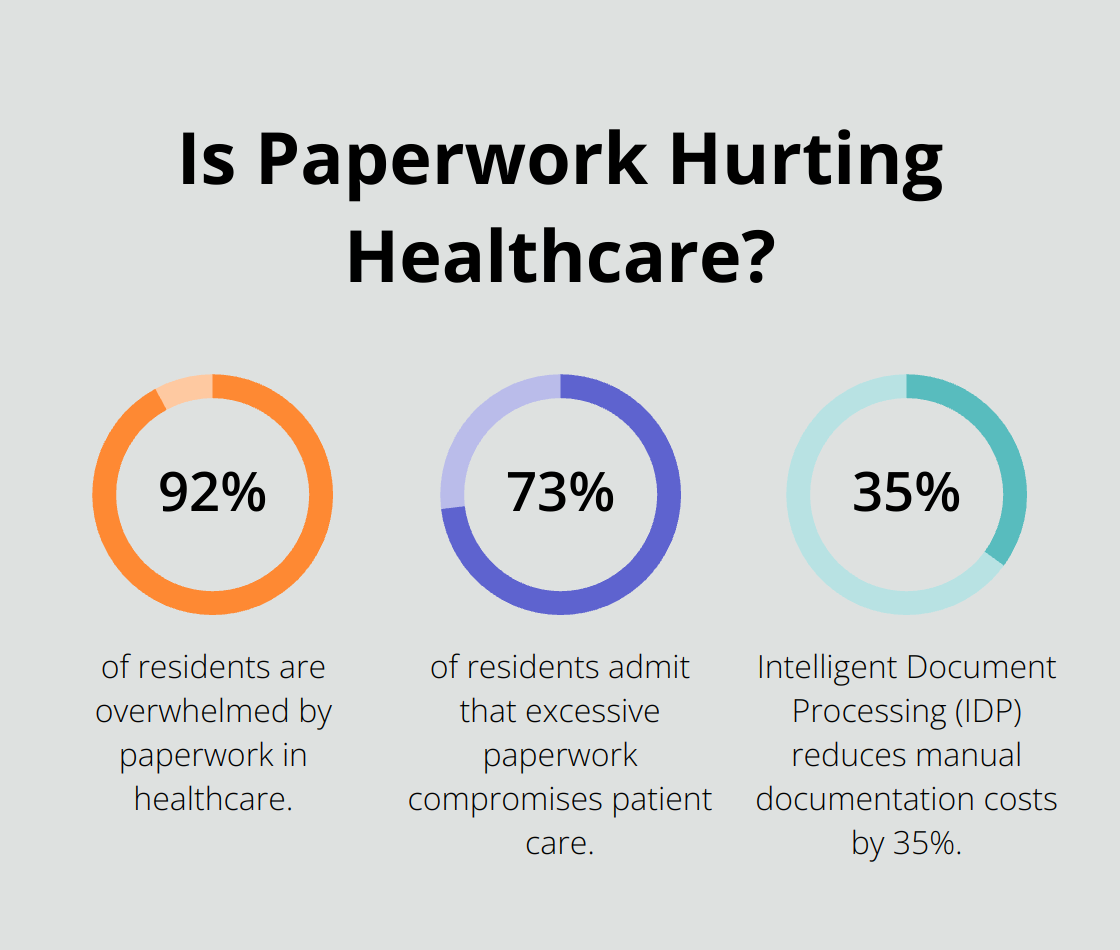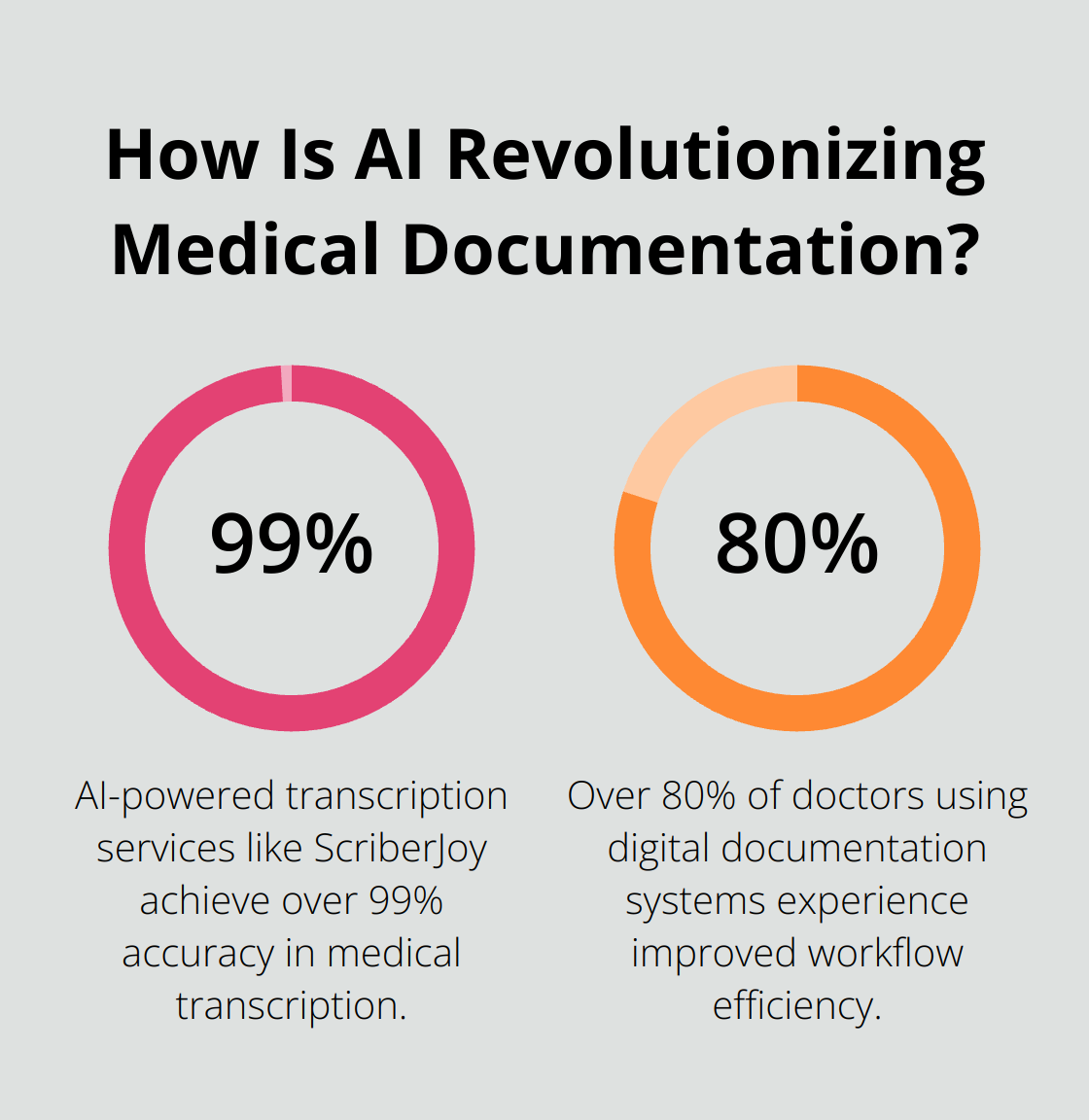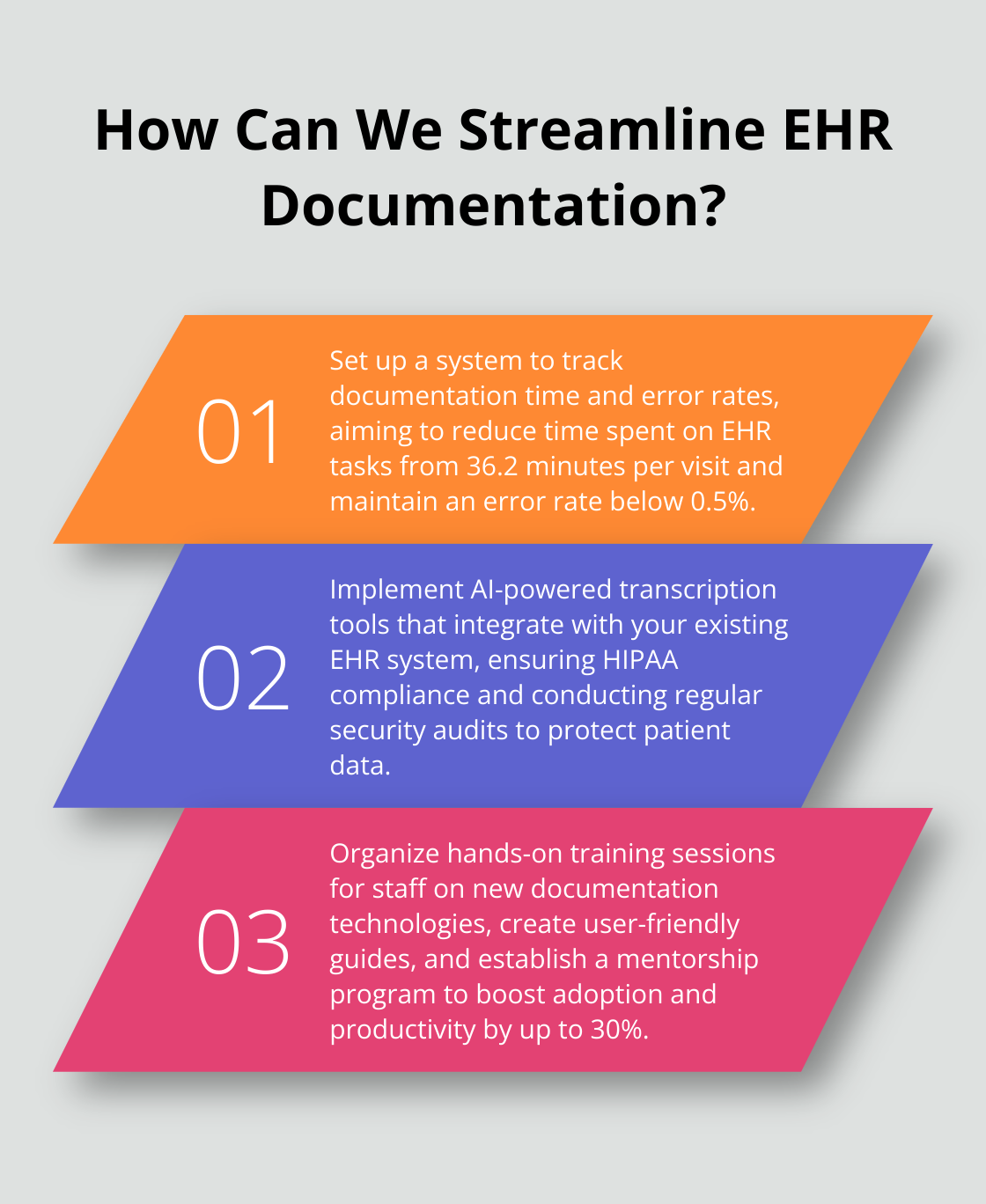Healthcare’s inefficiency is like that annoying fly buzzing around—outdated documentation practices are the fly. The paperwork? It’s a time-suck and an error magnet. And guess what? Patients aren’t thrilled with it either.
Enter ScriberJoy. We’ve witnessed (firsthand) how smart documentation can be the game changer for healthcare. This isn’t just a story about inefficiency; it’s a saga about solutions. We’re diving into how clunky documentation drags things down and showcasing the new tech that’s here to cut through the chaos and boost patient care.
The Hidden Costs of Inefficient Documentation in Healthcare
Healthcare is battling a silent beast: inefficient documentation. And this isn’t just some minor inconvenience-it’s a dominos-on-steroids effect that rattles patient care and clogs up the entire system.
Time Drain on Healthcare Professionals
Let’s talk time, or rather, lack thereof. The National Library of Medicine spills the beans: 92% of residents are drowning in paperwork, and 73% admit it’s a real-time bomb that compromises care. A study using ecological momentary assessment (EMA) shows physicians in outpatient care spend their days chained to the desk, pushing 1.5 to 2 hours daily into Electronic Health Record (EHR) tasks. It’s a one-way ticket from doctor-patient face time to doctor-data screen time. And yes, that’s as frustrating for docs as it is potentially dangerous for the folks they’re supposed to help.
The Error Ripple Effect
Ever seen a house of cards fall? That’s human error in data entry-0.67% of the time-at its finest. And when it’s your medical records, yikes. We’re talking misdiagnoses, bad prescriptions, and sometimes, folks getting hurt. Medical errors and the importance of corrective interventions should be top-of-mind for any healthcare pro worth their salt.
Patient Satisfaction Takes a Hit
Here’s the rub: overwhelmed docs mean peeved patients. You know the drill-long waits, rushed visits, and that impersonal “take-a-number” vibe. It’s a fun killer for patient satisfaction, directly tied to a system that’s straining under the weight.
Financial Implications
This isn’t just a clinical kerfuffle-it’s robbing the piggy bank. World Health Organization throws out some jaw-dropping digits: $42 billion-a year-lost to medication management errors alone. Toss in the dough lost on denied claims because of sloppy paperwork, and… ouch. But smart cats are turning to Intelligent Document Processing (IDP)-cutting 35% off manual documentation price tags.
The Path Forward
Here’s the wake-up call: inefficient documentation isn’t just a nuisance. It’s stripping time away from patients, brewing errors, ticking off patients, and hemorrhaging cash from the system. But, there’s salvation on the horizon with smart documentation tools. Think AI-driven transcription and automated data crunching (yep, like the stuff ScriberJoy does)-they’re out there ready to reel back time, slash errors, make patients happier, and give the budget some breathing room again.

Next up, let’s lift the curtain on these smart documentation gems, shining a spotlight on the way they not only boost efficiency but put the focus back where it belongs-on the patient.
Smart Documentation Tools Revolutionize Healthcare
The healthcare industry is witnessing a jaw-dropping shake-up in how docs document. We’re talking innovative tech that’s flipping the script on how medical pros snag and shuffle patient info. These smart tools are tackling the big fish-those efficiency nightmares that haunt healthcare folks.
AI-Powered Transcription: A New Era in Medical Documentation
AI-powered transcription services are spearheading the charge in smart documentation. They transcribe medical chats on the fly, letting docs actually look at patients instead of scribbling furiously. It’s a no-brainer-it cuts boo-boos, slashes costs, and smooths out the doc process for the med folks.

ScriberJoy? Yeah, it’s a standout. It’s rocking over 99% accuracy in med transcription with this wicked combo of AI and those good ol’ human checks. This dynamic duo nails the tricky med jargon just right, trimming down the oopsies that can wreak havoc on patient care.
Voice Recognition: Efficiency Speaks Volumes
Voice recognition tech? Leaps and bounds ahead of its awkward early years. It now gets the medical mumbo jumbo and the accents-making it a must-have tool for zippy, spot-on documentation. According to Healthcare IT News, over 80% of docs using digital documentation systems are seeing their workflow slick and streamlined.
These systems blend effortlessly with Electronic Health Records (EHRs), rolling out real-time updates to patient files. The payoff? Less doc-pushing, more patient-savvy care. It makes things way more organic between docs and patients, without the eternal typing or note-jotting.
Automated Data Entry: Precision at Scale
Automated data entry systems-those silent game-changers of smart documentation. They yank out the need-to-know bits from all over the place (lab reports, referrals, even chicken scratches) and pop them into EHRs like magic.
This kind of automation isn’t just slashing errors; it’s building a meatier picture of patient health. By pulling in data from here, there, and everywhere, these systems pack a mean punch for smarter decisions and tailor-made care plans.
Template-Based Documentation: Streamlined Efficiency
Template-based documentation tools bring order to the chaos of medical record-keeping. These templates-bespoke for your specific specialty or procedure-keep things consistent and buttoned up. They nudge healthcare pros to log all the essentials, cutting down on misses and blunders.
Using templates zips through the doc process. It’s all about quickly slotting in the right info without reinventing the wheel each time. That means more face-time with patients and a productivity boost in those bustling healthcare hubs.
As we push ahead, weaving these smart doc tools into healthcare settings isn’t just smart-it’s critical. Next up, how healthcare outfits can make these tech goodies part of their workflow, ensuring a slick transition and big wins for both providers and patients.
How to Implement Smart Documentation in Healthcare
Assess Your Current Documentation Process
So, here’s where you start – assess that current mess of a documentation process you’ve got. Clock the hours your people are buried under paperwork (ever seen a physician spend 36.2 minutes per visit on EHR? Yep, that’s a reality). Time to level up.

Next, face the music with your error rates. If you’re messing up more than 0.5%, that’s a train wreck waiting to happen. Tiny slip-ups? They snowball into big, hairy nightmares, impacting treatment and patient safety.
Select Appropriate Technology
Time to get choosy with your tech. Whatever smart tools you pick, they better play nice with your existing EHR system. Smooth transitions – the name of the game here.
And hey, AI-powered transcription is the cool kid on the block. Precise and snappy – but those documentation errors? They can lead to chaos, like misdiagnoses or botched treatments. Always, always tick those HIPAA compliance boxes (because, you know, patient data isn’t a joke).
Provide Comprehensive Staff Training
Roll out the new tech with all the bells and whistles in training. Fact – the Healthcare Financial Management Association knows a thing or two about productivity bumps (30% worth, not too shabby).
Host hands-on sessions, throw in some user-friendly guides, and set up mentor pairings for that communal boost. Then, just sell it – more face time with patients means more bandwagon jumpers.
Monitor and Optimize Implementation
Smart documentation isn’t a set-and-forget deal. You’ve got to watch it like a hawk. Line up those KPIs – measure documentation time, errors, patient smiles (aka satisfaction).
Keep the convo flowing with your team. Got bumps in the road? Squash them and tweak as needed. Vendors? Most offer a lifeline to keep the wheels turning smoothly on your shiny new system.
Ensure Data Security and Compliance
Lock down data security in your documentation strategy, no shortcuts here. Encryption fortress? Check. Access controls? Double check. Quarterly security audits – yes, it’s a thing you need.
Stay on top of those shifting healthcare rules. Align your documentation practices with the latest compliance codes. This proactive play? It keeps the legal gremlins at bay and secures patient trust in your organization’s data game.
Final Thoughts
Smart documentation… it’s the not-so-secret weapon that could drag healthcare kicking and screaming into the 21st century – injecting efficiency and precision into a sector that’s been gasping for air. Imagine: AI transcription, voice recognition… automated data entry – they slice through the mountain of paperwork, gifting precious time back to crucial patient care. These marvels don’t just hype – they slay administrative chaos, trim down errors, boost patient happiness, and chop unnecessary costs.

In this epic saga, technology’s the unsung hero. It forges smart systems – they learn, they adapt, they hold the hands of our healthcare warriors as they aim for stellar patient care. Leading the charge, ScriberJoy, turning the complex art of medical documentation into a science with AI that’s as sharp as a scalpel and backed by human smarts.
The road ahead? Paved with smart documentation. Healthcare providers aren’t just keeping up – they’re poised to transform, unleashing practices that not only enhance patient outcomes but also tackle the Herculean task of navigating our labyrinthine system – with ease, no less. As these sophisticated tools take root and strategies go live, we’re not just moving forward – we’re sprinting towards a healthcare system that places the patient at its heart.

Leave a Reply
You must be logged in to post a comment.